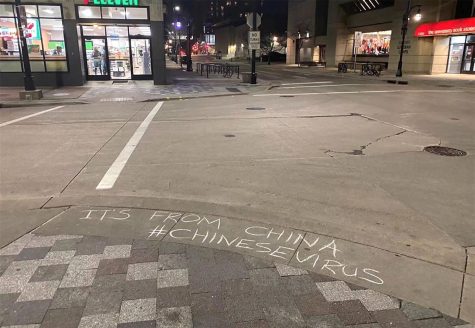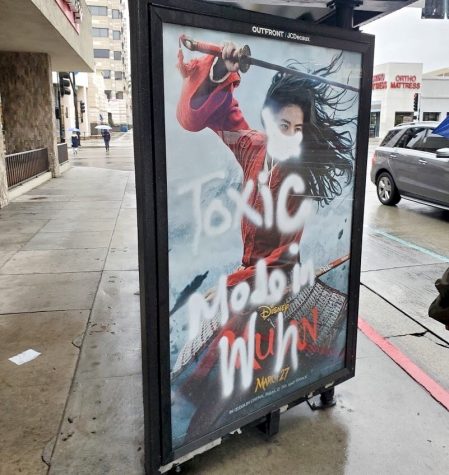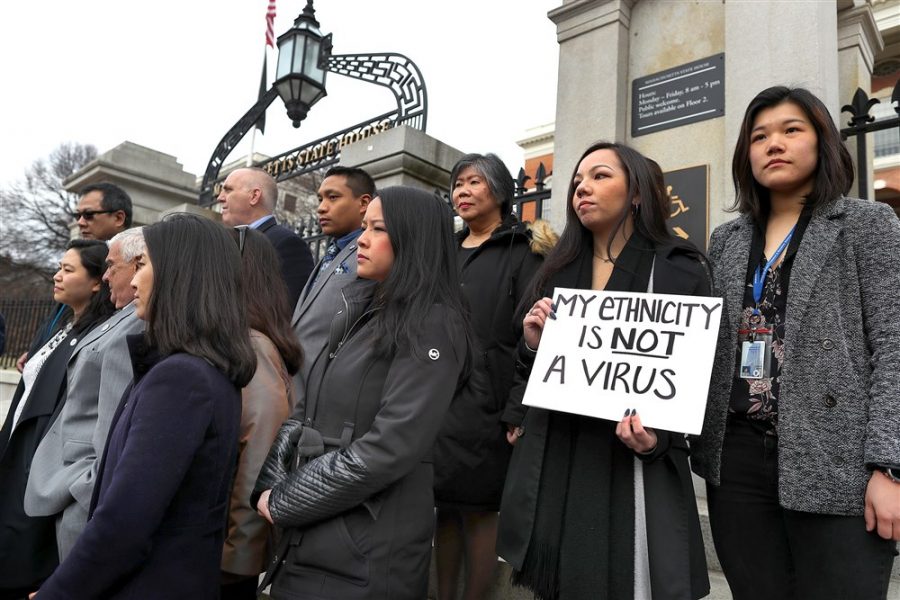Hate the Virus, Not the Asian American Community
John Tlumacki / The Boston Globe via Getty Images
March 12, 2020–Members of the Asian American Commission held a press conference commenting on the recent increase in racism towards Asian American communities.
Feb 25, 2021
Trigger Warning: The following article contains sensitive content that may be unsuitable for some readers.
There has been an alarming increase of publicized attacks against Asian Americans. An increase in both xenophobia, prejudice against people from other countries, and racism derived from the pandemic has been at its worst this year. Here are some recent examples in the past month:
- Jan. 28, 2021: Vichar Ratanapakdee, 84-year-old Thai immigrant, died of brain hemorrhaging after being shoved by a teen in San Francisco, California.
- Feb. 3, 2021: Noel Quintana, a 61-year-old Filipino man, slashed across the face with box cutters while waiting for the subway in Manhattan, New York
- Feb. 10, 2021: Group of Japanese citizens attacked with acid in Paris, France
- Feb. 16, 2021: 52-year-old Asian woman violently shoved in Queens, New York
- Feb. 19, 2021: 51-year-old Matthew Leung, an elementary school teacher aide, attacked while waiting for the bus in Rosemead, California
Just last year, the NYPD reported the rates of hate crimes driven by anti-Asian motives increased by 1,900%. Stop AAPI (Asian American Pacific Islander) Hate, a database that has been recording the number of racially charged attacks against the Asian communities received around 2,808 reports between March and December 2020. Yet, none of these attacks were considered “important” enough to reach a bigger audience. There isn’t enough coverage from the media detailing these revolting attacks. How many more Asian Americans need to be beaten and attacked for it to be newsworthy? Not once in the past month have I seen a report on the attacks in Asian American communities. I didn’t find out from any major news source…I found out from my mom’s Instagram.
The false assertion that Asian Americans are the “model minority” has heightened the ignorance of racial violence in Asian communities. The “model minority” tactic has been used by the government since the Civil Rights Era to argue that other minorities can overcome racism and poverty with hard work, obedience, and strong family values.
Even I’m guilty of following the model minority myth. Right? Assimilate to white American culture, don’t argue back, stay silent, blend in. That sounds about right! In the media, shows like Netflix’s Bling Empire create this perception that Asian Americans are well-off, educated, and law-abiding, which begets belief in the model minority myth. However, according to a 2016 PEW research study, Asians are the most economically divided group in the United States. The stereotypical idea that Asian Americans have not struggled and are all well-off is downright incorrect.
Because Asians are assumed to possess socioeconomic, educational, and class privilege, it is often forgotten Asian Americans do experience discrimination. The term “model minority” was used to show how the American dream can be achieved, but what this created was a divide between the Asian race and African Americans in the 1940s. And now the divide has become greater with other people of color, leaving Asian Americans blurred in the middle of a war of races.

Adding to the already present racism was COVID-19. When referring to Covid-19 as “the China virus” or “Kung flu,” it created a more permissible environment to attack Asian American communities.
The xenophobic rhetoric is increasing as more people continue to view and accept the idea that Asian Americans are the cause of the pandemic. Because people feel that the Asian community is the cause of COVID-19, it gives them the initiative to normalize hate and discrimination towards Asians. In Queens, a 52-year-old lady was shoved, yelled racial slurs at, and left with stitches; her attacker, on the other hand, was released without bail. Vichar Ratanapakdee, an 84-year-old man, was violently shoved to his death while on his daily walk by an 18-year-old this month.

Some of these attacks aren’t even violent but instead destructive and verbal. In Philadelphia, a restaurant named a dish “Covid Mac” because it contained a Chinese ingredient. In San Jose’s historical Japantown, a monument honoring Japanese immigrants was defaced just this month. In San Gabriel Valley, a highly populated Asian American city in California, a Mulan poster was defaced to cover her face with a white mask with the word “Toxic, Made in Wuhan” marked over it.
This isn’t just happening in the United States. In London, Jonathan Mok, a 23-year-old college student, was attacked by a group of men, one of his attackers yelling, “I don’t want your Coronavirus in my country.” In the Netherlands, Jiye Seong-Yu, a Korean interpreter, was biking when two men yelled at her “Chinese” while attempting to punch her off her bike. The stories can go on forever, affecting people of all ages, ethnicities, and nationalities.
The stories are hard to hear, and the videos are especially heartbreaking to watch, but they need to be seen. Earlier this week, my family and I talked through all the events and how scary it is to be Chinese today. The most unsettling detail that we all agreed on is how grateful we were that my great-grandma (who passed away six years ago) isn’t around to experience this type of racism. Living in a suburb just north of Chicago, we haven’t experienced this kind of racial violence firsthand, but we are all too aware that it can happen.
I have friends in both San Diego and Queens, the biggest hotspots of these attacks, and every day they worry that one of these stories we see on the news about another elderly man or woman getting attacked while on a walk will be their grandparents. They worry that even though they were born in the United States, they might be subjected to one of these attacks.
That’s something I worry about, too.
The worst part about this is that many of the senior citizens who have suffered attacks are immigrants who cannot speak English. They cannot defend themselves. They came to America with the same goal as our founding fathers, which is to give their children and their grandchildren and later descendants a chance to succeed and grow.
When we think about our elders, we should be worried about them not exercising enough or eating the right foods, but we shouldn’t have to worry about them being the main target of racial hatred.
I’m angered and disgusted that there is a person in this world, in the 21st century, who thinks it’s okay to attack someone, especially a senior citizen, because of their race. In Asian culture, respecting our elders is our most cherished rule. I love my grandparents, I love my aunts, my uncles, and my parents. A 16-year-old shouldn’t have to worry about her grandparents simply going to the grocery store or taking a walk.
Both my grandparents came to America from China with no money, no family, absolutely nothing except the courage to flee a communist country. They didn’t come here to wait 50 years to conspire to release a viral weapon on America. They came here to give my parents, my brother, my cousins, and me the ability to go to school and follow our dreams. And now, as I sit in my room during remote learning, I have to hope that when my 77-year-old grandpa goes out to Home Depot to get flowers for his garden, he won’t be pushed down or beaten. I have to hope that my 11-year-old cousin doesn’t have to harden himself against racist rhetoric from his classmates. I hope he doesn’t start believing that it’s okay to tolerate hate and follow the model minority myth.
I am Chinese and was shocked by the lack of coverage surrounding this problem, so I’m taking it upon myself to share these stories. It’s as easy as reading through the Stop AAPI Hate website, reading posts from NextShark, or sifting through posts with the #StopAsianHate tags on Instagram. You cannot fight racism with more racism. We have to end it together. We’re your friends, family, neighbors, classmates, colleagues, etc., so reject the false narratives, and if you are Asian, speak out. You have a voice; it’s time to use it and tell your story.





Seema Chandarana • Mar 21, 2021 at 4:16 PM
Thank you, Emily, for each word so carefully presented in your article. Your voice is powerful. I am humbled and honored to have you on my roster this year, albeit remotely!